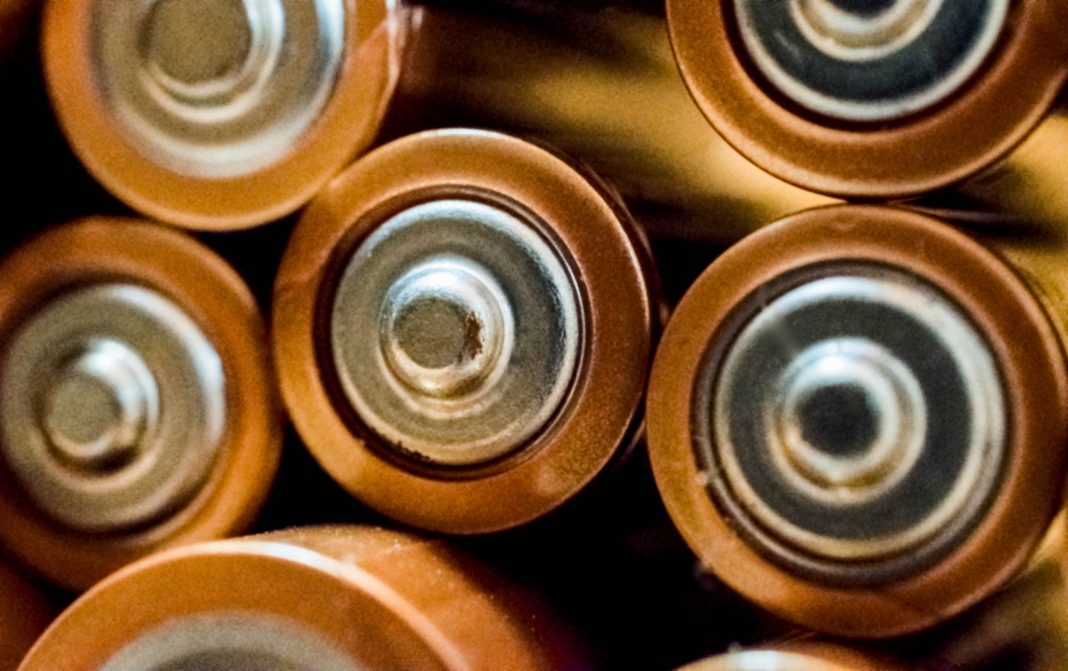 |
|
| Issue #142 • July/August, 2013 |

Completed charging station after sanding and painting
Let me guess the reason many of you do not use rechargeable batteries is that every time you need to recharge an electronic device you have to wait all day for it to recharge. Normally you replace batteries when you try to operate your remote control, digital camera, or flashlight and discover the batteries are dead. You need your device to work now, and that means throwing out the old batteries and putting in new ones so you can use the device immediately.

This jar full of discarded batteries is typical for many households.
The solution is to always have rechargeable batteries ready to use that are fully charged and easy to locate, as it’s just as easy to switch out dead batteries with new batteries as it is to replace rechargeable batteries that are out of power with another set that are fully recharged. New rechargeable battery technology allows recharging more than 1000 times which means you may never have to purchase regular batteries again.
In addition, since the new types of rechargeable batteries can hold their charge for a year or more, you can now recharge spare batteries then store these for future use without worrying that they will have lost their charge by the time you actually need them.
Discarded button batteries containing mercury-oxide contribute to almost 90% of the mercury going into today’s landfills, while dry cell batteries contribute to half of all cadmium and nickel found in our landfills. It is estimated the United States discards more than 3 billion dry cell batteries each year, which is more than 35 AA, AAA, C, D, and 9-volt size batteries per family. While this may be a reasonable national average, I think for many homes with teenagers this number will actually be far higher.
Two years ago I decided that maybe it really was not a good idea to discard old batteries in the trash, and decided to save up for proper disposal since they could contain unsafe materials that should not go into a landfill. I had a large pretzel jar available and wrote “Discarded Batteries” on the side. I placed this container next to the door of our office and after two years it was completely full.
To extend the life of disposable batteries, many manufacturers are switching to heavy metals in their battery construction such as nickel, cadmium, lead, mercury, and acid. If discarded in landfills, these potentially toxic materials can leach into our lakes or groundwater, or if incinerated can become harmful airborne ash.

New rechargeable battery technology
I consider my list of battery-powered devices to be similar to most readers of this magazine, yet I never imagined I could have actually gone through so many batteries so quickly. I do have a flashlight in every vehicle, several AM/FM portable radios, and can’t forget all those TV and appliance remote controls, digital cameras, and battery-powered games and tools.
I must admit my impression of rechargeable batteries was formed years ago when they would not hold a charge for long and did not provide the same run-time as regular batteries. I also did not like having to keep up with different battery chargers for each battery size, and did not like having to wait an entire day to recharge the batteries in a device I needed to operate now.
After seeing this jar full of discarded AAA, AA, C, D, and 9-volt size batteries, I decided there must be a better way. I discovered that today’s rechargeable batteries are much more reliable than the earlier technology I remember, and there are now more types to pick from.
The secret of switching over to only rechargeable batteries is to have a central location in your home, garage, or business specifically for storing recently recharged batteries of various sizes, and having a single charger capable of charging multiple sizes of batteries at the same time. I also found that it is much easier to make the switch to rechargeable batteries cold turkey. In other words, switch all of your flashlights, portable radios, and remote controls from non-rechargeable to rechargeable batteries at the same time. This reduces the chance of accidently discarding an expensive rechargeable battery and replacing with a low-cost non-rechargeable battery because they do look alike.

Multi-size battery chargers
This article includes very detailed instructions for building your own charging station using basic hand tools. I suggest first taking inventory of your battery-powered devices and identifying the most common battery sizes you use. Since rechargeable batteries are not cheap, this may be a good time to start buying replacement rechargeable batteries so you will be ready to use the battery charging station as soon as it’s finished. In order to always have a fresh set of rechargeable batteries, you will need extras for each size you are using. For example, if you have two remote controls that each require two “AA” size batteries, you should purchase a minimum of eight AA rechargeable batteries (2 remote controls x 2 batteries x 2 sets = 8).
Battery charge capacity

1. Organize materials needed.

2. Build bottom drawer assembly first.

3. Next, add side and rear bracing.

4. Attach rear wall bracing.

5. Frame in electrical strip.
It is fairly easy to find stores that sell rechargeable AA and AAA batteries; these sizes are popular for digital cameras which are known to eat batteries due to their high energy demand. Other rechargeable battery sizes are harder to find, especially for the mid-sized C cell and rectangular 9-volt battery. I ended up ordering these hard-to-find rechargeable batteries over the Internet and found some great discounts for quantity orders, so I ordered eight each of the most common sizes I needed.
Since cell phones and tablet computers have built-in rechargeable batteries, they usually require their own special battery charger. However, in an effort to centralize all battery charging, I moved my cell phone chargers to the same charging location so there is no longer a scavenger hunt each day trying to find the correct charger that matches the device I am trying to recharge.
Rechargeable battery technology
As mentioned in the introduction, today’s rechargeable batteries are higher quality and have a much longer life than earlier designs. The most popular rechargeable batteries sold today are nickel-metal hydride (NiMH). The nickel-cadmium (NiCd) rechargeable battery is an older technology and is being replaced by the newer NiMH batteries. The NiMH battery technology will store two to three times more energy than the older NiCd technology and can be recharged more than 1000 times. There is also an updated version of the NiMH battery technology which has an extremely long self-discharge called LSD NiMH. These can hold 90% of their charge for up to a year and 75% of their charge for up to two years. Even without the LSD design feature, most rechargeable batteries will hold their full charge for at least six months.
The lithium-ion (Li-Ion) batteries typically found in today’s cell phones, laptop computers, and portable power tools provide even more charge capacity while weighing less. However, most of these are either built into the device or are supplied with their own special charger that matches their unique shape and charging cycle requirements.
When I started my conversion to all rechargeable batteries, I found a wide difference in charging capacity from one battery manufacturer to another. For example, the highest quality D cell rechargeable batteries from Sanyo have a 11,000 milliamp-hour (mAh) rating, while some cheaper rechargeable batteries were found to be in the low 8,000 mAh range. While less expensive, this 28% lower charge capacity would translate into a similar drop in device operating hours.
Since flashlight and digital camera-size batteries have a much smaller charge capacity than the amp-hour ratings used for comparing car batteries, a smaller scale milliamp-hour (mAh) rating is used, which is just amp-hours divided by 1000. A flashlight battery (D cell) with a 10,000 mAh rating will have twice the stored power of a similar-sized battery having a 5,000 mAh rating. Unfortunately, these ratings are not always easy to identify without reading the small print, so when you are shopping for rechargeable batteries, remember that the brand that costs half as much may also have half the recharge capacity.
There are some rechargeable battery brands and models that consistently out-perform all others. Professional photographers needing reliable flash performance, first responders needing life-saving portable 2-way radio communications, and field technicians needing reliable battery-powered test equipment soon learn which rechargeable batteries give the best service. Based on their recommendations and my experience, I have compiled my list of rechargeable batteries that are consistently rated highest for charge capacity and reliability. I am sure there are other brands equal or better than my list, so you can check their mAh rating against my Table ratings to see how they compare before making a purchase.
Table 1 compares some of the best rechargeable batteries I have found along with their corresponding capacity ratings. When shopping for rechargeable batteries, use these ratings as a benchmark.
One reason many people are getting away from the older NiCd battery technology is its “memory effect.” If you try to recharge a NiCd battery when it still has some charge remaining, it will return to the discharge level you started from and will no longer provide power below this starting charge level. If you plan on using rechargeable NiCd batteries to save cost, you need to make sure the battery charger has “smart charging” technology which can correct this problem.

High quality chargers can automatically tell which type of battery has been inserted and will first remove any remaining charge in an NiCd battery before starting a full charge cycle. The newer NiMH battery technology does not have this “memory effect” so your charger will fully recharge these batteries starting from any level of discharge. If you are testing batteries with a volt-meter or battery tester, keep in mind all nominal 1½ volt NiMH batteries will actually measure 1.2 volts, not 1.5 volts, when fully charged, and all nominal 9-volt NiMH batteries will actually measure 9.6 volts when at full charge.
If your budget allows, I strongly recommend using only nickel-metal hydride (NiMH) rechargeable batteries which can be recharged more than 1,000 times and do not have the memory effect problem of nickel-cadmium (NiCd) batteries.
You will also want to purchase a multipurpose battery charger that will automatically recognize which type of battery is inserted, determine its starting point charge level, and then stop charging when fully recharged. You also want a battery charger that can recharge any combination of AAA, AA, C, D, and 9-volt size batteries at the same time. The most common models will recharge four batteries at a time, while more expensive chargers are able to charge 8 to 16 batteries at a time.
I found several good quality battery chargers that were reasonably priced and had all the features I have described. The “AccuManager 20 Charger” by AccuPower costs $48 and has four charging slots plus two 9-volt battery spaces. The “Ansmann Deluxe Energy 8 Charger” has eight charging slots plus a really nice digital display that indicates the charge level of each battery individually, which I found online for $56. The Maha Ultimate Professional Charger also has a nice digital display and space for 8 batteries. It has a slightly higher charging rate than the other lower-cost chargers and I found it online for $83.
The chargers for your cell phones, iPods, and pagers usually come with their own chargers so you will only need to relocate these chargers to your charging station.
Battery charger station
There are many advantages to doing all battery charging at a central location. For example, since all chargers will be together, you will no longer have to hunt all over for your cell phone or iPod charger. Since most battery chargers consume some electrical power even when not charging, by plugging all chargers into the same electrical strip outlet, it’s easy to turn all chargers off with one switch when not needed. Having a central battery charging station provides a good place to store extra rechargeable batteries that have been fully recharged and ready for immediate use.
Charging station construction
My goal was to make a charging station that was small and light enough to be portable when needed. All the materials including the plastic drawer were purchased at a local building supply for less than $30, not including the paint or stain you may select for a finish.
I purchased the thinner 1/8-inch cabinet plywood to make the wall sides, top, and bottom. I purchased a 4 foot length of ½ x 2-inch poplar for stiffeners, a three-foot length of 1 x 1-inch square poplar for the top and side spacers, and a 2-foot length of ½ x 3-inch poplar to frame in the drawer. The drawer is actually a 14-inch Plano ProLatch Stowaway Organizer with the top removed, which cost $4.97 and was also available where I purchased the wood materials. The electric strip outlet has six plugs, surge arrestor, and illuminated on/off switch and cost $13.97.
All materials were assembled with construction glue and a pneumatic finish nailer, although you could use small screws or finish nails. I installed the strip outlet before gluing on the back plate to give it a built-in look, and sanded all corners and joints before painting. Refer to the exploded drawing detail.

Closing comments
I made the entire charger station portable and purchased 12-volt car adapters for each charging device. Now if we have a power outage lasting days, I can relocate the charging station next to the generator or in whatever vehicle that is still operating. This allows me to recharge all my battery-powered devices during an extended power outage.
Finally I added a 12-watt fold-out solar module which provides a great way to power each charger during an extended power outage when fuel may not be available to operate a generator or vehicle. With a charging station that can be powered by the utility, a generator, a car 12-volt outlet, or solar module, you will no longer have to worry about power outages shutting down your cell phone or iPad, and will be able to keep your portable radio and several LED flashlights operating indefinitely.
[weaver_widget_area id=’articles_about_yago’ class=’text3′]














